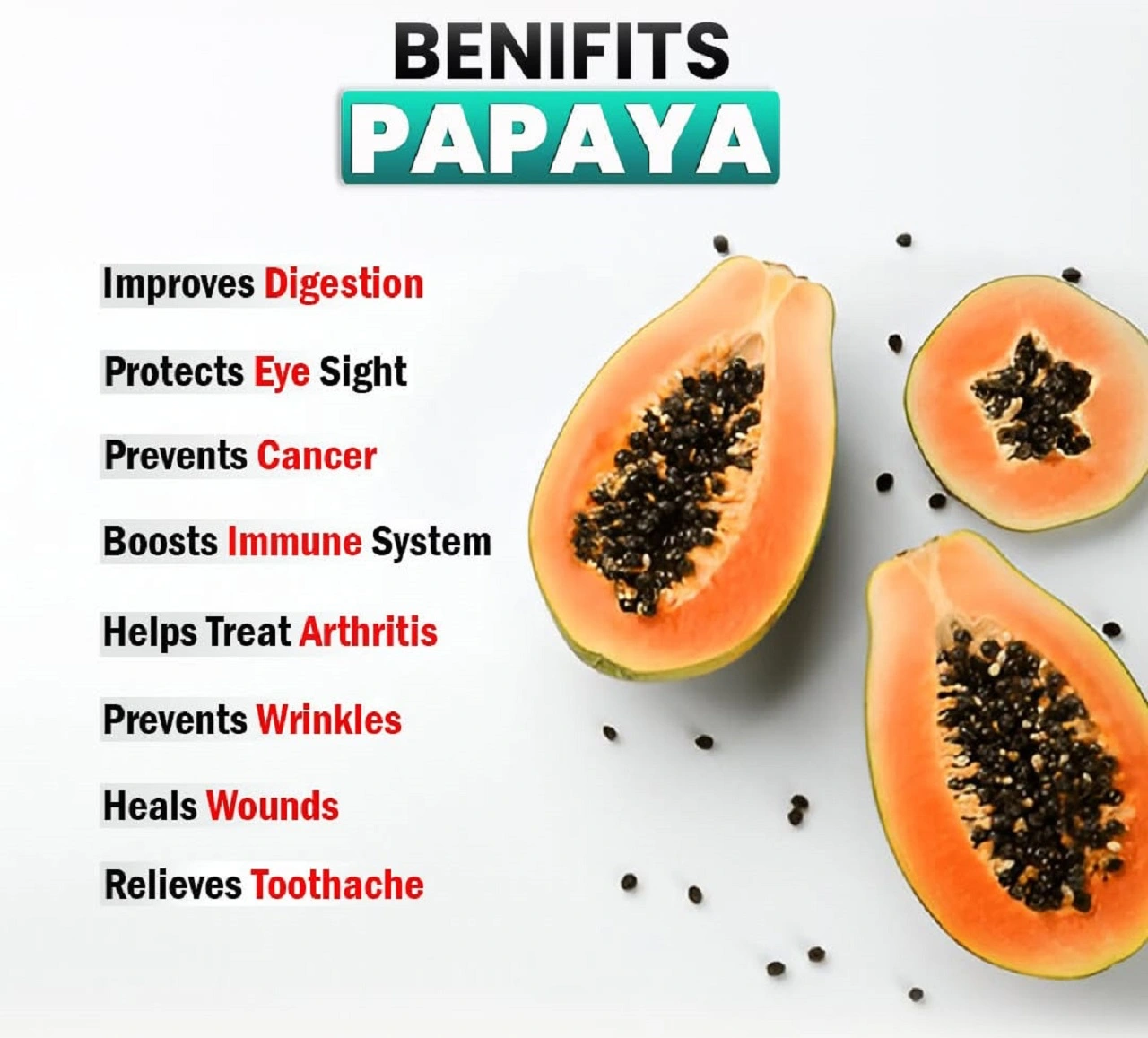Introduction
Papaya is a tropical fruit loved for its sweet taste, vibrant color, and impressive health benefits. Whether you enjoy it fresh, blended into smoothies, or added to salads, papaya is a versatile fruit that adds both flavor and nutrition to your plate. In this article, we’ll explore everything you need to know about papaya from its nutritional value and health benefits to how to eat it, store it, and why you should make it a part of your daily diet.
What is Papaya?
Papaya, also known as “pawpaw” in some regions, is a tropical fruit that grows in warm climates. It has a soft, buttery texture and a sweet flavor. The fruit is oval-shaped, green when unripe, and turns yellow or orange when fully ripe. Inside, papaya contains black seeds surrounded by soft, orange flesh that is rich in nutrients.

Nutritional Value of Papaya
Pawpaw is low in calories but high in essential vitamins and minerals. A 100-gram serving of ripe papaya provides:
- Calories: 43
- Vitamin C: 75% of the daily requirement
- Vitamin A: 20% of the daily requirement
- Folate: 10% of the daily requirement
- Potassium, magnesium, and fiber
Papaya is also packed with antioxidants like beta-carotene, which helps protect your body from free radicals.

1. Papaya Boosts Immunity
One of the best reasons to eat pawpaw is its high vitamin C content. Just one serving gives you more than enough to support your immune system. Regular consumption of papaya helps your body fight off common illnesses like colds and flu.
2. Aids in Digestion
Papaya contains a natural enzyme called papain that helps break down protein, making it easier for your body to digest food. This is why papaya is often recommended for people with digestive problems such as bloating or constipation. It’s a gentle and natural way to support gut health.
3. Great for Skin and Hair
Thanks to its high levels of vitamin A and C, pawpaw is amazing for skin and hair. Vitamin A helps repair skin tissues, while vitamin C promotes collagen production, giving your skin a youthful glow. Some even use mashed papaya as a face mask to reduce acne and dark spots.
4. Supports Heart Health
Eating papaya regularly can help maintain a healthy heart. It contains fiber, antioxidants, and potassium, all of which contribute to lower cholesterol levels and better heart function. A diet that includes pawpaw can reduce the risk of heart disease and high blood pressure.
5. Helps in Weight Management
Papaya is low in calories but high in fiber, which makes it an excellent choice for those looking to lose or manage weight. Fiber keeps you full for longer, reducing cravings and unnecessary snacking. Plus, it’s a naturally sweet treat that doesn’t spike blood sugar.
6. Anti-Inflammatory Properties
Papaya has anti-inflammatory compounds like papain and chymopapain that help reduce inflammation in the body. This makes it beneficial for people with arthritis, joint pain, or other inflammatory conditions. Including pawpaw in your diet may help manage chronic pain.
7. Promotes Eye Health
The beta-carotene in pawpaw is converted into vitamin A in the body, which is essential for good vision. Regular consumption of papaya can prevent night blindness and age-related eye issues like macular degeneration.
8. May Reduce Cancer Risk
Some studies suggest that the antioxidants in pawpaw, especially lycopene, may help reduce the risk of certain types of cancer. These compounds protect your cells from damage and reduce oxidative stress, which plays a role in cancer development.
9. Supports Liver Health
Papaya is believed to have liver-cleansing properties. It helps flush out toxins from the body and promotes liver function. Pawpaw seeds, in particular, are known for their detoxifying effects and may be used (in moderation) to support liver health.
10. Good for Diabetics
Despite its sweet taste, pawpaw has a low glycemic index, meaning it doesn’t cause a rapid spike in blood sugar. This makes it a great fruit option for people with diabetes. The fiber also helps control blood sugar levels.
How to Eat Papaya
Pawpaw is incredibly easy to enjoy. Here are some common ways to eat it:
- Eat it fresh: Just peel, remove the seeds, and slice it.
- Add it to fruit salads or smoothies.
- Use it in desserts like sorbets or puddings.
- Combine with lime juice for extra flavor.
Some people also consume dried Pawpaw or use the seeds for their health benefits (though seeds have a bitter taste and should be eaten in moderation).
How to Choose and Store Papaya
When buying pawpaw, look for fruit that is slightly soft to the touch with yellow skin. Green papayas are unripe and firmer but can be used in cooking. Store ripe pawpaw in the fridge to extend freshness for a few days. If it’s still green, leave it at room temperature to ripen.
Side Effects and Precautions
Papaya is generally safe for most people, but pregnant women should avoid consuming unripe papaya as it may cause uterine contractions. People allergic to latex may also be allergic to pawpaw. Always consult your doctor if you’re unsure about including new foods in your diet.
Frequently Asked Questions (FAQs)
Q1. Is it good to eat papaya every day?
Yes, eating pawpaw daily is beneficial as it supports digestion, boosts immunity, and provides important nutrients. Just make sure to eat it in moderation.
Q2. Can papaya help with weight loss?
Absolutely! Pawpaw is low in calories and high in fiber, making it a perfect snack for those aiming to lose weight.
Q3. Is papaya safe during pregnancy?
Ripe pawpaw is generally considered safe, but unripe or semi-ripe papaya should be avoided during pregnancy as it may cause uterine contractions.
Q4. Are pawpaw seeds edible?
Yes, pawpaw seeds are edible and have detoxifying properties, but they should be eaten in small quantities due to their strong taste and potential side effects.
Q5. What is the best time to eat pawpaw?
Pawpaw can be eaten any time of the day, but it’s especially good in the morning to help digestion and start your day with a nutrient boost.
Q6. Can diabetics eat pawpaw?
Yes, pawpaw has a low glycemic index and is safe for diabetics when consumed in moderation.
Q7. Is pawpaw good for the skin?
Definitely! Its vitamins and antioxidants help keep the skin clear, youthful, and glowing.
Q8. Does pawpaw help in constipation?
Yes, the enzyme papain and fiber in pawpaw help improve digestion and relieve constipation naturally.
Q9. Can I eat pawpaw on an empty stomach?
Yes, pawpaw on an empty stomach is excellent for digestion and detoxification.
Q10. Is green pawpaw healthy?
Green (unripe) pawpaw is rich in enzymes and can be used in cooking. It’s also healthy, especially when used in soups or stir-fries.
Final Thoughts
Papaya is more than just a tropical fruit it’s a powerhouse of nutrients with a wide range of health benefits. From improving digestion to boosting immunity and enhancing skin health, pawpaw deserves a regular spot in your diet. It’s easy to eat, affordable, and incredibly nutritious. So, the next time you go grocery shopping, don’t forget to grab a ripe pawpaw and enjoy its natural goodness.